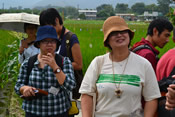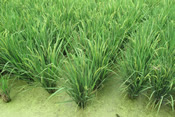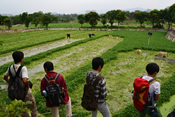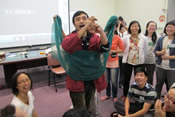By Chen Ying-en, Vickie (The content of this article is drawn from the sharing of Tsai Pei-hui of Taiwan Rural Front in "Touching the Ground, Taking Root--Seminar on CSA Experience".)
 Meaning of "rural rejuvenation": Rethinking the mode of production
Meaning of "rural rejuvenation": Rethinking the mode of production
Instead of describing Taiwan Rural Front as an organisation, it might be more accurate to use the term "social group" to describe its multifarious practices in different places and the action network formed by people of different social status and positions. They include farmers, intellectuals, students and community workers. What were the circumstances that brought these people together? In 2008, the Council of Agriculture of Taiwan's Executive Yuan (Government) drafted the Rural Rejuvenation Act, which stated clearly from the outset that "the purpose is to build a new rural area that urban dwellers will enjoy so much they will not want to go home." The Council of Agriculture planned to do this by initiating large numbers of landscape projects, such as constructing and installing bicycle lanes and pavilions. If this is what "rejuvenation" means, is there any chance for Taiwan's rural villages to free themselves from the unfair structural position they have been placed in over the course of history and to revive themselves? Does the Act meet the practical needs of Taiwan's rural villages? In Taiwan, there is a group of people who have doubts on these questions.
The subject of the law has in fact been changed stealthily by the Rural Rejuvenation Act. Rural areas, where productive activities are going on and where many live, have become an object for sightseeing. The Act has ignored the fact that rural areas provides us with an assortment of food supplies and that it is rural society that brings together the agents for production. The Act has also ignored that there is a cultural system behind rural society and that it is all the above-mentioned that nourish Taiwan's rural areas and give rural life its depth. Taiwan's countryside does need to be "rejuvenated", but what it needs is a reconsideration of the mode of production—not large-scale production, but a congenial connection between producers and consumers and between cities and villages. The countryside needs 'construction'[2] , but not 'decorative construction' or 'landscape construction' that destroys the original landscape along with its human textures. What rural areas need is infrastructure. In the early years, paddy rice was mainly cultivated in the countryside in Taiwan. Irrigation and drainage were combined in one system. Now diverse crops are cultivated in rural areas. Fields are often found next to residential areas and factories. When chemical fertilisers and pesticides are used, pollution spreads quickly. For this reason, there is an urgent need to build infrastructure that separates irrigation from drainage. This was the suggestion of a farmer who takes part in the activities of the Front. Drawing on his practical experience in farming, he reminded us that while "tearing down the old stuff", we had to "establish something new". To establish something new, there has to be a solid and steady course of actions when we go into rural villages because only then are we able to understand more closely the way of thinking, the language, production activities and everyday lives of farmers.
Seeking the foundations of what is new: Enlightenment in rural villages
The Taiwan Rural Front and Hao Ran Foundation have launched two projects: "Small Farmers Resuming Farming" and the "Bow to Land Festival". The purpose of these projects is to "establish something new". When we reflect on the value of nong, we should not limit ourselves to theory and discourse. Our reflection should be able to be transformed into everyday experience, because only then are we able to bring about change. Taking "Bow to Land Festival" as an example, the Front is trying to build a connection between urban dwellers and nong directly through the food on their dining tables. What the Front hopes to achieve is not only having people consume the food. Instead, through the small farmers' market, the "people" who produce the food and the environment and context of farming are brought together so that they may get to know each other and become concerned for each other's well being. "Bowing" is our hope that a relationship of care and concern be developed between human beings and land, and that such a relationship can be established in a Taiwan society fixated on development and materialism. "Bowing" is the practical form of labour on the farms—bending, hoeing, weeding or transplanting seedlings. Taking part in farm labour allows those who have left their rural homes and young people who have little connection with or love for the countryside to realise that farming entails a unique set of skills and that these skills and crafts cannot be passed on by words alone. Only by learning the labour process (yes, "learn" to labour) will we become conscious of our position in relation to land, environment and farmers—a position that should be more humble and recognise the subjectivity of the other. Only through such a labour process will such a position be able to take root in the countryside. Farming is one aspect of "rural craft". The other aspect is creating cultural elements by means of thinking in the context of nong. A group of art school students in the Front and a group of young people from Meinong who are in close contact with the Front have been trying to unearth cultural icons and symbols distinct from production to help interpret the vitality and the cultural dimensions of nong. These creations of rural/farming aesthetics help people to rethink the cultural depth of the countryside as it has been developed in Taiwan over the years. People are beginning to ask: "What is the agricultural civilisation and rural culture of Taiwan like?" This is also a journey of searching for our roots.
A running fight: Go slowly step by step while reflecting on each step taken
How do we, the Front, engage different social groups and sustain their participation? And how do we gain influence and open up space—for both theories and actions? The credit for the start of all this work, and for the dialogue, connection-building and convergence of people of different generations, backgrounds and identities, should not be granted to the Front. Instead it is thanks to the support of society at large. To put it more concretely, society has already been reflecting, first, on the mainstream development ideology, and second, on materialism in Taiwan that has brought problems such as extreme weather events, food safety, and food crises. It is in this context that people have started to ask where their food comes from and where the countryside is going. People have joined together for reasons connected with nong, and they have continued to reflect on their relationship with nong and land. In this process, the impetus to change the status quo has grown and concrete programmes are placed on the agenda for discussion. What sort of practice is implied in the slogans "rooted in nong" and "for the use of nong"? Members of the Front have been experimenting and practising in many places including rural areas. Going slowly, we are fighting as we run and we reflect on every step we take. Before we take a step forward, we want first to take root in the soil of real life.
- In Chinese, nong means farmer, agriculture and rural.
- The word 'construction' here is a literal translation from Chinese language 'Jianshe' which is closer to 'development' in English.





